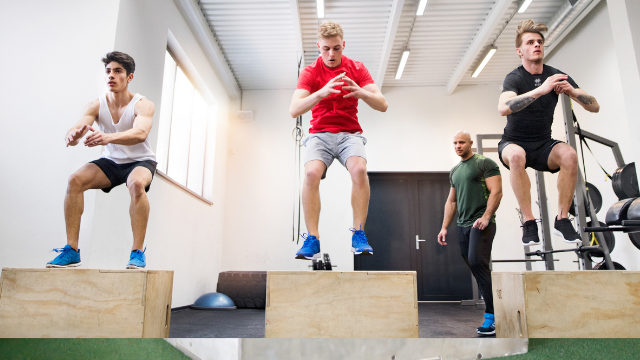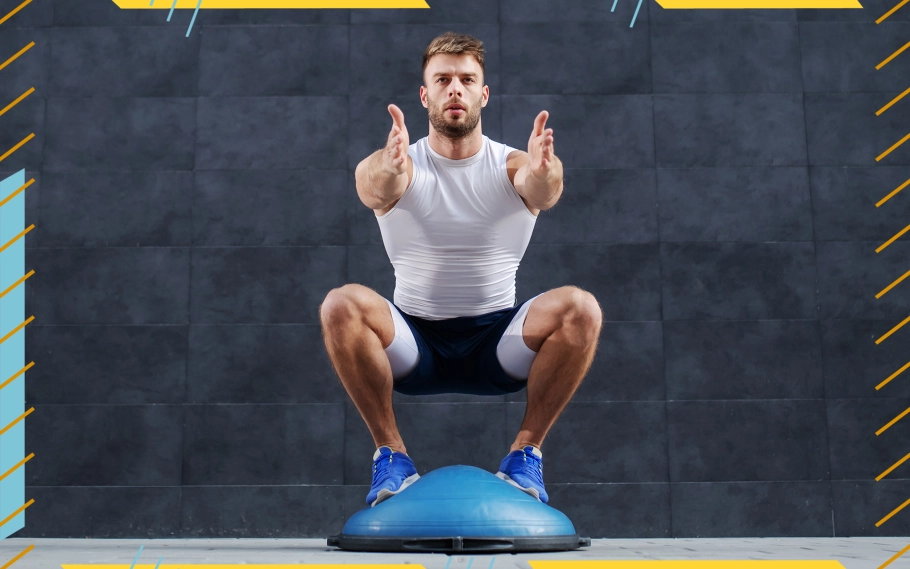Definition of Plyometric Exercises
Plyometric physical games are a form of excessive-depth, explosive movement that entails speedy stretching and contracting of the muscles. These sporting activities are designed to increase power, velocity, and agility, and are often utilized by athletes and fitness enthusiasts to decorate their overall performance.
Plyometrics make use of the stretch-shortening cycle of the muscle tissues, which involves an eccentric muscle contraction followed with the aid of an immediate concentric contraction. This kind of motion creates a large amount of force in a brief quantity of time, that’s why plyometrics are regularly called “bounce training.”
Some not unusual examples of plyometric physical activities encompass box jumps, squat jumps, lateral hops, burpees, and tuck jumps. These physical activities target multiple muscle businesses, together with the legs, glutes, center, and higher body, making them a comprehensive workout choice.
Overall, incorporating plyometric physical activities into your exercises can offer severa blessings, consisting of improved strength, speed, agility, balance, persistence, and fats burning.
Overview of the Benefits of Plyometrics
Plyometric exercises offer numerous benefits for both athletes and fitness enthusiasts. These high-intensity, explosive movements can improve physical abilities, reduce the risk of injury, and enhance overall fitness. Here are some of the key benefits of incorporating plyometric exercises into your workouts:
- Improved Power and Speed: Plyometrics are designed to increase the power and speed of the muscles, making them ideal for athletes and fitness enthusiasts looking to improve their performance.
- Enhanced Agility and Balance: Plyometric exercises require quick, controlled movements, which can help improve overall balance and agility.
- Reduced Injury Risk: By strengthening the muscles and improving coordination, plyometrics can help reduce the risk of injury during other physical activities.
- Increased Endurance: Plyometrics are intense exercises that can increase cardiovascular endurance and improve overall stamina.
- Increased Fat Burning: Plyometric exercises are a type of high-intensity workout that can help increase metabolism and burn fat more effectively.
Incorporating plyometric exercises into your workouts can provide numerous benefits for both athletic performance and overall fitness. Whether you’re an athlete looking to improve your power and speed or simply looking for a more challenging workout, plyometrics are a valuable addition to any training regimen.

Improved Power and Speed
Explanation of Power and Speed Development: Power and speed are critical physical attributes that are essential for many athletic activities. Power refers to the ability to generate force quickly, while speed refers to the ability to move rapidly. Improving these attributes can help enhance athletic performance and reduce the risk of injury.
How Plyometrics Can Improve These Attributes: Plyometric exercises are specifically designed to increase power and speed. By utilizing the stretch-shortening cycle of the muscles, plyometrics can improve the rate at which force is produced. This, in turn, leads to increased power and speed. Plyometric exercises also require rapid, explosive movements that can help improve overall speed and quickness.
Examples of plyometric exercises that can help improve power and speed include box jumps, squat jumps, and tuck jumps. These exercises target multiple muscle groups, including the legs, glutes, and core, and require quick, controlled movements that can help improve overall power and speed.
Incorporating plyometric exercises into your workouts can provide numerous benefits for both athletic performance and overall fitness. Whether you’re an athlete looking to improve your power and speed or simply looking for a more challenging workout, plyometrics are a valuable addition to any training regimen.
Enhanced Agility and Balance
Explanation of Agility and Balance: Agility and balance are bodily skills which are important for lots athletic activities. Agility refers back to the ability to exchange path speedy and easily, while stability refers to the potential to maintain stability and manage over one’s body. Improving these competencies can help decorate athletic performance and decrease the threat of harm.
How Plyometrics Can Improve These Physical Skills: Plyometric sports require brief, controlled movements which could help enhance standard stability and agility. These physical activities additionally involve rapid changes in path, that may help enhance universal agility.
Examples of plyometric exercises that can assist enhance agility and balance include lateral hops, hurdle jumps, and single-leg hops. These physical activities goal multiple muscle organizations, together with the legs, glutes, and core, and require brief, managed moves that could help enhance average agility and stability.
Incorporating plyometric sporting activities into your workouts can provide numerous blessings for both athletic performance and overall fitness. Whether you’re an athlete looking to enhance your agility and balance or absolutely searching out a more tough exercising, plyometrics are a valuable addition to any training routine.

Reduced Injury Risk
Overview of Injury Risks in Workouts: Physical activities, including workouts, carry a risk of injury. This can include sprains, strains, and other common injuries related to overuse, poor form, and lack of conditioning. It’s important to take steps to reduce the risk of injury in order to maintain physical health and prevent setbacks in your workout routine.
How Plyometrics Can Decrease the Risk of Injury: Plyometric exercises are designed to strengthen the muscles and improve coordination. By improving these physical abilities, plyometrics can help reduce the risk of injury during other physical activities. Plyometric exercises also target multiple muscle groups, including the legs, glutes, and core, and can help improve overall stability and control, which can reduce the risk of injury.
Incorporating plyometric exercises into your workouts can provide numerous benefits for both athletic performance and overall fitness. Whether you’re an athlete looking to reduce the risk of injury or simply looking for a more challenging workout, plyometrics are a valuable addition to any training regimen.
Increased Endurance
Explanation of Endurance: Endurance refers to the ability to sustain physical activity for an extended period of time. Improving endurance can help enhance athletic performance and overall physical fitness.
How Plyometrics Can Improve Endurance: Plyometric exercises are typically performed in a high-intensity, interval format, which can help improve overall endurance. These exercises require quick, explosive movements that can help improve overall cardiovascular fitness and increase the body’s ability to sustain physical activity.
Examples of plyometric exercises that can help improve endurance include plyometric circuits, where multiple plyometric exercises are performed in succession, and plyometric intervals, where plyometric exercises are alternated with periods of rest.
Incorporating plyometric exercises into your workouts can provide numerous benefits for both athletic performance and overall fitness. Whether you’re an athlete looking to improve your endurance or simply looking for a more challenging workout, plyometrics are a valuable addition to any training regimen.

Increased Fat Burning
Overview of Fat Burning: Fat burning refers to the process by which the body uses stored fat as energy. This can help improve overall physical fitness, as well as contribute to weight loss and a reduction in body fat.
How Plyometrics Can Help with Fat Loss: Plyometric exercises are typically high-intensity, interval-style workouts that can help increase overall calorie burn and promote fat loss. These exercises require quick, explosive movements that can help increase heart rate and boost metabolism, making them an effective tool for burning fat.
Additionally, plyometric exercises can help build lean muscle mass, which can boost metabolism and increase overall fat burning potential. Incorporating plyometric exercises into your workouts can provide numerous benefits for both athletic performance and overall fitness.
Whether you’re looking to burn fat and improve overall physical fitness, or simply looking for a more challenging workout, plyometrics are a valuable addition to any training regimen. With their high-intensity, interval-style format, they can help boost metabolism and promote fat loss, helping you achieve your fitness goals.
Examples of Plyometric Exercises
A. Box Jumps: Box jumps are a popular plyometric exercise that can help improve power and explosiveness. To perform a box jump, start by standing in front of a box or sturdy platform. Squat down and then jump onto the box, landing with both feet. Step or jump back down to the ground, and repeat for several repetitions.
B. Squat Jumps: Squat jumps are a simple plyometric exercise that can help improve overall power and explosiveness. To perform a squat jump, start by standing with your feet shoulder-width apart. Squat down, then jump as high as you can. Land softly, and repeat for several repetitions.
C. Lateral Hops: Lateral hops are a plyometric exercise that can help improve agility and coordination. To perform a lateral hop, start by standing with your feet shoulder-width apart. Hop from one foot to the other, landing softly. Repeat for several repetitions, moving quickly and smoothly.
D. Burpees: Burpees are a full-body plyometric exercise that can help improve overall fitness. To perform a burpee, start in a standing position. Squat down and place your hands on the ground, then kick your feet back into a push-up position. Perform a push-up, then jump your feet back up to your hands and stand back up. Repeat for several repetitions.
E. Tuck Jumps: Tuck jumps are a plyometric exercise that can help improve overall power and explosiveness. To perform a tuck jump, start by standing with your feet shoulder-width apart. Jump as high as you can, bringing your knees up to your chest. Land softly, and repeat for several repetitions.
These are just a few examples of plyometric exercises that you can incorporate into your workouts. Whether you’re an athlete looking to improve your athletic performance or simply looking for a more challenging workout, plyometrics are a valuable addition to any training regimen.
Conclusion
Summary of the Benefits of Plyometrics: Plyometric exercises are a type of high-intensity, interval-style workout that can provide numerous benefits for both athletic performance and overall fitness. These exercises can help improve power and speed, enhance agility and balance, reduce injury risk, increase endurance, and boost fat burning.
Final Thoughts on Incorporating Plyometrics into Your Workouts: Whether you’re an athlete looking to improve your performance or simply looking for a more challenging workout, incorporating plyometric exercises into your routine can provide numerous benefits. However, as with any type of exercise, it’s important to start slowly and gradually increase intensity to avoid injury.
Consult with a doctor or personal trainer to determine if plyometrics are right for you and to develop a safe and effective training plan. With the right approach, plyometrics can help you achieve your fitness goals and improve your overall health and wellness. More Tips Click Here
